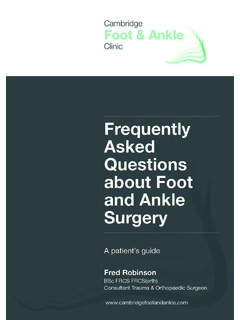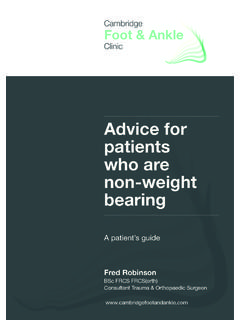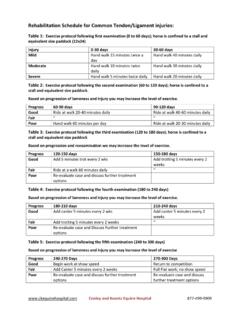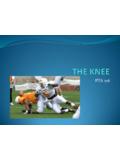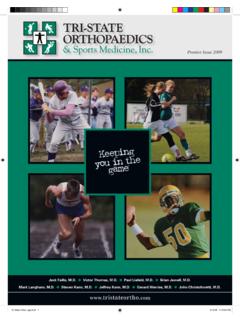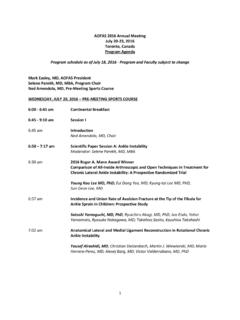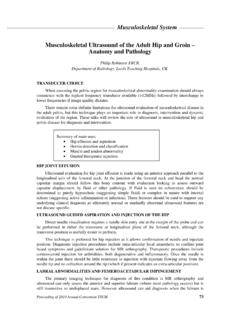Transcription of Cambridge Foot & Ankle
1 CambridgeFoot & AnkleClinicFred RobinsonBSc FRCS FRCS(orth)Consultant Trauma & Orthopaedic Surgeon patient s guideCambridge foot and Ankle Clinic T: 01223 518989 F: 01223 847436 Ankle LigamentsFred Robinson BSc FRCS FRCS(orth) Consultant Trauma & Orthopaedic SurgeonA patient s guideWhat are the ligaments of the Ankle ?The Ankle is a hinge joint between the leg and the foot , and allows up and down movement. The bones of the leg (tibia and fibula) form a slot, and the talus bone of the foot fits between them. The talus is held to the tibia and fibula by strong bands of tissue called ligaments. Each ligament is made of many strands or fibres of a material called collagen, which is extremely ligament on the inside of the Ankle (the deltoid ligament ) has two layers; the deepest one is most important.
2 This ligament is mainly torn in association with severe fractures of the Ankle bones. Sporting injuries of this ligament are ligament on the outside of the Ankle (lateral ligament ) is made up of three separate bands: one at the front (anterior talo-fibular ligament ), one in the middle (calcaneo-fibular ligament ) and one at the back (posterior talo-fibular ligament ). The front and middle bands are the ligaments injured in a tibia and fibula form a joint between themselves just above the Ankle . This also has strong ligaments, one at the front and one at the back (tibio-fibular ligaments). The ligament at the front is involved in 10-20% of Ankle sprains; this injury is important, as it takes a long time to heal, although it usually heals without the need for surgical & AnkleClinicHow do the Ankle ligaments get injured?
3 Most Ankle ligament injuries are caused when the foot twists inwards. All of the body s weight is then placed on the lateral Ankle ligaments. The anterior and middle fibres of the Ankle stretch or tear a in sprain or strain of the Ankle . Occasionally small pieces of bone may be torn off with the a few cases, a twisting force on the Ankle may cause other damage. The bones around the Ankle may be broken, a piece of the cartilage lining the Ankle may be chipped off, ligaments connecting other bones in the foot may be sprained or torn, or the tendons around the Ankle may be foot and Ankle Clinic T: 01223 518989 F: 01223 847436 Ankle LigamentsFred Robinson BSc FRCS FRCS(orth) Consultant Trauma & Orthopaedic SurgeonA patient s guideMost Ankle sprains are fairly minor injuries , which will get better with simple self-care treatment.
4 The word RICE reminds us of the basic treatment of a sprained joint: Rest - take the weight off the injured joint as much as possible for a day or two Ice - an ice pack (a small bag of frozen peas is ideal) can be applied for 10-15 minutes, 3-4 times a day to reduce swelling Compression - a support bandage or strapping will help to reduce the swelling Elevation - resting with the Ankle above the height of the body will allow swelling to drain away into the bloodstreamAlthough a couple of days rest is useful, it is best to start taking some weight on the injured Ankle reasonably soon after injury, usually within 2-3 days. Also start to exercise and stretch the injured Ankle as soon as possible after the a sprained Ankle will recover within 6-8 weeks, although it may tend to swell for a few months should I do if I sprain my & AnkleClinicIf you have a severe Ankle injury it is best to get professional advice immediately.
5 Things that suggest a severe injury include: your Ankle is so painful that you cannot walk on it all the Ankle looks deformed the skin over the Ankle is broken the injury was caused by a severe force such as a fall from a height or a blow from a heavy object the pain and swelling seem to get worse rather than better over the first 3-4 days (the bruising often gets worse for a week or more before it starts to fade)When should I go to casualty? Cambridge foot and Ankle Clinic T: 01223 518989 F: 01223 847436 Ankle LigamentsFred Robinson BSc FRCS FRCS(orth) Consultant Trauma & Orthopaedic SurgeonA patient s guideMost simple sprains get better without any special treatment.
6 However, if you have a severe injury or the initial injury does not recover normally, it is usually best to see a hospital casualty or orthopaedic department, your own GP or your sports club can arrange this. Physiotherapists also advertise in Yellow Pages and local majority of Ankle injuries get better completely and cause no long-term problems. Unfortunately occasionally there is permanent damage to the ligaments may fail to heal properly and become weak leading to Ankle instability, or there may be damage to the joint itself or some other structure nearby - leading to Ankle pain and I have physiotherapy?Will I keep having trouble with my & AnkleClinicYour doctor or physiotherapist will listen to your complaints about your Ankle and examine you.
7 They will look for any sign that you have some other problem around your Ankle , such as damage to the joint surface. They will stretch your Ankle to see if the ligaments are abnormally X-ray will usually be taken to see if there is any damage to the bones of your Ankle . Ligaments do not show on X-rays. ligament damage can be shown by taking X-rays with your Ankle stretched in various directions ( stress views ) or with a magnetic (MRI) scan. However, these special tests are usually not needed at would Ankle instability be diagnosed? Cambridge foot and Ankle Clinic T: 01223 518989 F: 01223 847436 Ankle LigamentsFred Robinson BSc FRCS FRCS(orth) Consultant Trauma & Orthopaedic SurgeonA patient s guideWhat can be done about Ankle instability?
8 Most people with Ankle ligament instability have damage to the ligaments, which can be overcome with appropriate physiotherapy rehabilitation. The rehabilitation concentrates on two main areas. Firstly strengthening the muscles around the outside of the Ankle . Secondly, by improving your balance. This may require the use of specialised equipment such as a wobble-board, or a trampette. However, similar exercises can be practised at home by using a cushion, or a piece of sponge. Your physiotherapist will help you with your Ankle or Achilles tendon are stiff, you will also be shown exercises to stretch these. If your foot shape makes you prone to extra stress on the Ankle ligaments, a moulded insole may be advised for your shoe to reduce these people will find their Ankle much more stable and comfortable after physiotherapy.
9 However, in some people problems continue. At this point the opinion of an orthopaedic foot and Ankle surgeon may be helpful, and your general practitioner may refer you for further treatment. The surgeon may also suggest an exploratory operation on your Ankle (arthroscopy) to check on the state of the joint. If these tests suggest weakness of the Ankle ligaments, an operation may be & AnkleClinicWill I need an operation?Most people with Ankle instability will not need an operation. Even if your Ankle still feels unstable after physiotherapy, you could try a brace rather than having an operation to tighten up or replace the , if no other treatment makes your Ankle comfortable and tests show that the ligaments are weak, an operation may help.
10 There are two main types of operation: the damaged ligaments are tightened up and re-attached to the bone. one of the nearby tendons is used to replace the damaged surgery you will be in plaster for six weeks. After this you need to wear an Ankle brace for a further 6 weeks. Physiotherapy treatment is usually required. After 3 months you will work with your physiotherapist to regain the strength, and mobility of your Ankle . You can start light exercise at 3 months, but sport involving twisting (such as football, rugby, running on rough ground and squash) are not allowed until 6 months after the foot and Ankle Clinic T: 01223 518989 F: 01223 847436 Ankle LigamentsFred Robinson BSc FRCS FRCS(orth) Consultant Trauma & Orthopaedic SurgeonA patient s guideWill I need an operation?
